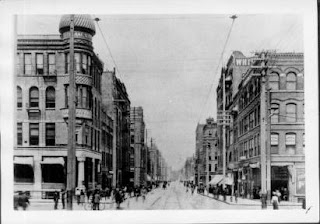In 1912, George Pettet, son of William Pettet was assistant secretary of the Spokane & Eastern Trust Company. He is buried next to his mother in Fairmont cemetery (lawn 14 sec 7c). His sister, Minnie, who was my grandfather's first wife, died in 1894 and is also buried there.
________________________
The following article appeared on page 6 of the Spokane Daily Chronicle on Tuesday, September 8, 1936.
 |
| Howard St. from Sprague Spokane & Eastern Trust Co. on left Trader's National Bank bloc under construction Spokane Public Library Northwest Room Digital Collections |
Striking figures in connection with Spokane's financial growth during the years are pointed out today in connection with the Spokane & Eastern's fifth anniversary in its new quarters.
Five years ago today the bank moved into its new building at Howard and Riverside, on the same day Joel E. Ferris, for many years a director, became president, succeeding R. L. Rutter, who became chairman of the board. More than 40,000 persons passed through the bank at the opening.
At the time the move was made, deposits of the Spokane & Eastern totaled $11,800,000. Today deposits aggregate more than $28,000,000.
The records reveal that on May 4, 1894, Spokane's eight banks reported total deposits of $1,365,705. Today, years later, deposits in the banks of Spokane total approximately $60,000,000, and those of the Spokane & Eastern have grown, during the same period, from $29,000 to more than $28,000,000.
Institutions Merge.
 |
| Looking along Howard St. Spokane & Eastern Trust Co. building on left Spokane Public Library Northwest Room Digital Collections |
Both institutions combined on their boards of directors and among their officers many of the pioneer founders of Spokane. The first board of the Traders National included D. M. Drumheller, Michael M. Cowley, Jacob Hoover, Robert W. Forrest, who was the first mayor of the town of Spokane, and several others. The Spokane and Eastern founders included J. P. M. Richards, its first president and chairman; Henry M. Richards, the pioneer head of the Washington Water Power company; R. L. Rutter, J. D. Sherwood, Horace L. Cutter and many other well-known pioneers. The two banks consolidated in 1914 under the name of the Spokane & Eastern Trust company.
In the same year the Northwest Loan and Trust company, headed by Samuel Galland, was absorbed by the Spokane and Eastern, Mr. Galland becoming senior active vice president.
________________________
The following article appeared in the Spokane Daily Chronicle on Thursday, December 4, 1952.
Spokane and Eastern Bank Traces Growth in Book
 |
| Howard street looking North across Riverside Avenue intersection. Trader's National Bank building to the left. Spokane Public Library Northwest Room Digital Collections |
The booklet is being distributed in conjunction with the dedication Saturday of the bank's new and enlarged Inland Empire headquarters on Howard between Riverside and Sprague.
Containing numerous pictures, charts and drawings the booklet traces the growth of the Spokane and Eastern division.
Reproductions of two impressive murals being painted by Edward Grigware of Cody, Wyo., nationally famous artist, are on the inside front and back covers of the booklet.
Grigware is a former Spokane resident. His huge murals will be hung on the west wall of the block-long lobby of the enlarged headquarters building.
One mural shows Lewis and Clark, accompanied by scouts and Indians, looking over the Inland Empire in 1805. Members of the Lewis and Clark expedition were supposed to be the first white men to see the Inland Empire.
The other mural is Grigware's interpretation of the great Spokane fire of August 4, 1889. The legend under the mural says that "fire broke out and before the flames could be brought under control a courageous, young city lay in ashes. Its spirit unbroken, Spokane arose from the flames--the Queen City of the Inland Empire."
The mural shows a group of people in the foreground and burning buildings in the background. Above the buildings, in the smoke, is arising a woman with arms outstretched.
Besides a history of the Spokane and Eastern division, there is a story of the development of the Inland Empire, complete with seven pictures.
On the cover of the booklet is a picture of the completed building. On the back cover is an aerial picture of Spokane.
No comments:
Post a Comment